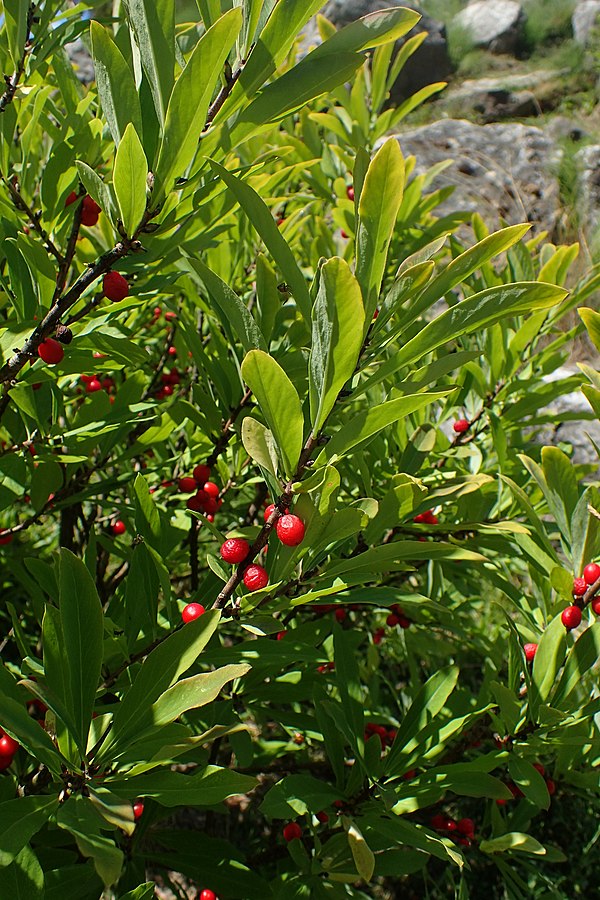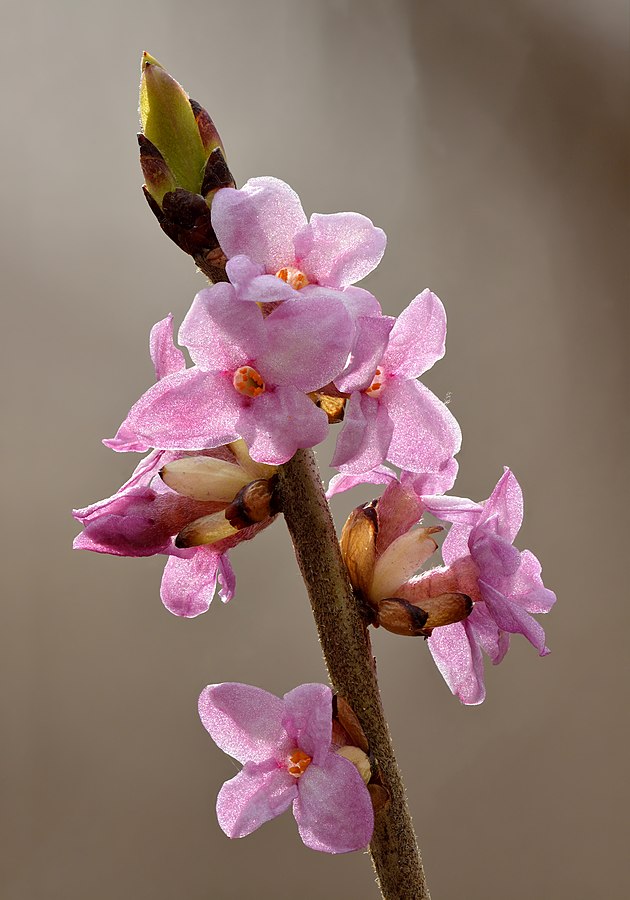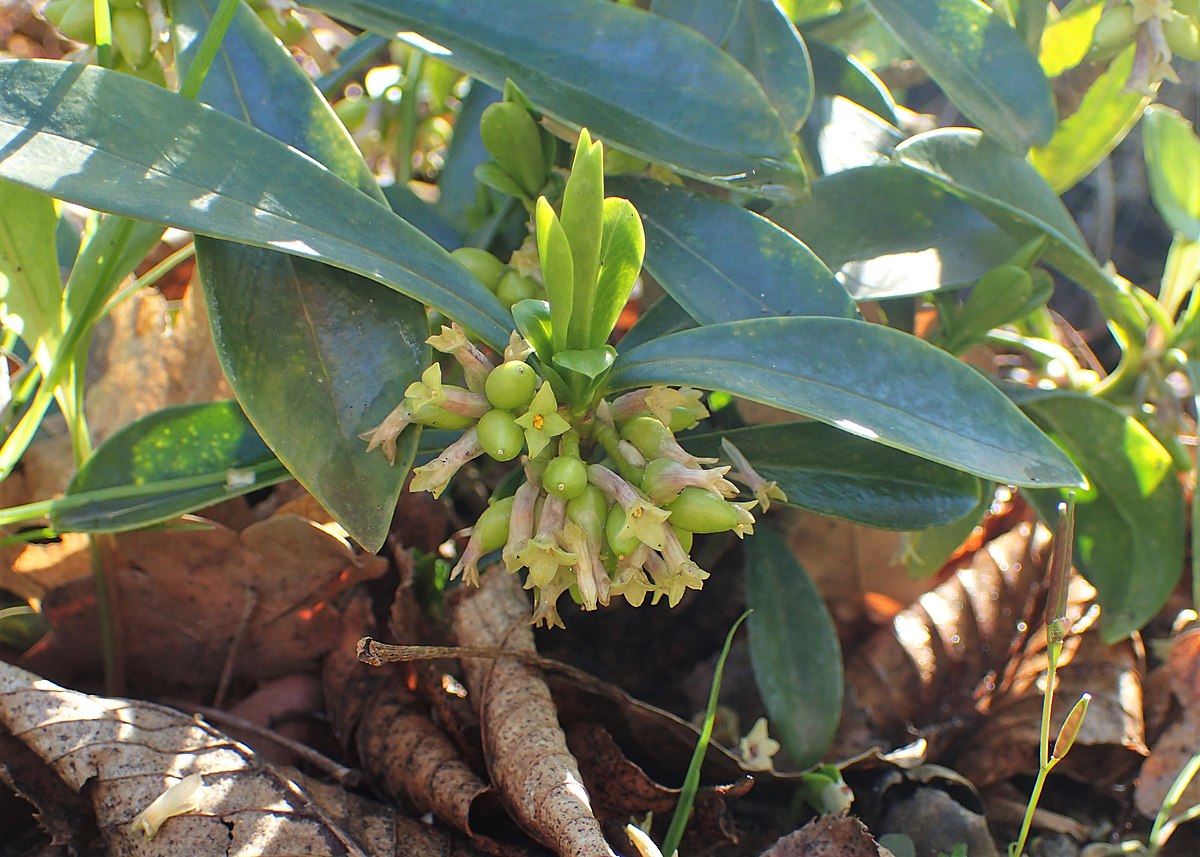- Home
- Plants
- Woody plants
- Trees & shrubs
- Mezereon
Mezereon Daphne mezereum
Family – Thymelaceae Daphne family
Small shrub – up to 60 cm tall c50cm spread
Flowering – February to March
Soils - Neutral to alkaline
Position – Full sun or partial shade
This beautiful small shrub bears very fragrant bright pink flowers on bare branches in January or February, a characteristic which has long earned it a place in gardens. Later in the year scarlet berries appear among the leaves. All parts of this plant are poisonous, although birds seem unaffected and eagerly take the berries, leading to bird-sown seedlings of this plant appearing both in gardens and in the wild.
This plant is believed to be native in calcareous woods in some places in England1., but wild examples are often bird-sown making its true native distribution difficult to ascertain. Gerard grew this plant in the 16th century but seemed unaware that it grew in the wild in Britain2.. It was first recorded from the wild in 1752, when Miller described it as growing in Hampshire3.. A few years later the naturalist Gilbert White found it growing in chalk woodland near his Hampshire home, and he transplanted some to his garden4.. It is likely that this attractive species was persistently stolen from the wild by gardeners, leading to it being very scarce in the wild today.
The name mezereon is Arabic in origin and was borrowed by mediaeval herbalists from the writings of the Persian physician and scientist Ibn Sina or Avicenna (980-1037)5. .The name of the genus Daphne was first applied by Linnaeus, borrowing the name the ancient Greeks had used for the unrelated bay tree (Laurus nobilis)6. . The mezereon has few traditional names and they are mostly versions of the word mezereon; however in Somerset and Gloucestershire it acquired the name "paradise plant" 5. .
This plant is easy to grow in good soil in dappled shade, and is widely available from garden centres. It resents disturbance and is best planted when young, taking care not to disturb the root ball.
Mezereon is recorded as host to only two insect species7. , a gall midge Dasineura daphnes, and the aphid Macrosiphum daphnidis. Both are confined to species of Daphne.
A related species, the spurge laurel Daphne laureola is found in similar situations in open deciduous woodlands on calcareous soils in England and Wales and is more common in the wild than D. mezereum, being frequent in some localities1. . It was also recorded earlier, by Turner in 15623. .The spurge laurel forms a small bush with evergreen glossy foliage and pale green flowers in bunches towards the top of the stems, also in January or February. The flowers are faintly scented and provide a source of nectar for insects on the wing on warm days early in the year. This plant is rewarding to grow in the garden although not as conspicuous in flower as D. mezereum. Black berries appear later in the year. All parts of this species are also poisonous.


Spurge laurel Daphne laureola
References
1. Stace, C. 2010 New Flora of the British Isles, Third Edition. p381.
2. Gerard, J. 1597. The Herball or Generall Historie of Plantes.
3. Pearman, D. (2017) The Discovery of the Native Flora of Britain and Ireland. BSBI, Bristol p 174
4. White, G. 1789. A Natural History of Selborne. The transplanting to his garden is described in his Journals, cited
in Mabey, R. 1996. Flora Britannica.
5. Grigson, G. 1995. An Englishman’s Flora. P. 194.
6. Linnaeus, 1753. Species Plantarum.
7. Biological Records Centre database
Page written by Marc Carlton, compiled by Steve Head

.jpg)
Mezereon Daphne mezereum
Small shrub – up to 60 cm tall c50cm spread
Flowering – February to March
Soils - Neutral to alkaline
Position – Full sun or partial shade


This beautiful small shrub bears very fragrant bright pink flowers on bare branches in January or February, a characteristic which has long earned it a place in gardens. Later in the year scarlet berries appear among the leaves. All parts of this plant are poisonous, although birds seem unaffected and eagerly take the berries, leading to bird-sown seedlings of this plant appearing both in gardens and in the wild.
This plant is believed to be native in calcareous woods in some places in England1., but wild examples are often bird-sown making its true native distribution difficult to ascertain. Gerard grew this plant in the 16th century but seemed unaware that it grew in the wild in Britain2.. It was first recorded from the wild in 1752, when Miller described it as growing in Hampshire3.. A few years later the naturalist Gilbert White found it growing in chalk woodland near his Hampshire home, and he transplanted some to his garden4.. It is likely that this attractive species was persistently stolen from the wild by gardeners, leading to it being very scarce in the wild today.
The name mezereon is Arabic in origin and was borrowed by mediaeval herbalists from the writings of the Persian physician and scientist Ibn Sina or Avicenna (980-1037)5. .The name of the genus Daphne was first applied by Linnaeus, borrowing the name the ancient Greeks had used for the unrelated bay tree (Laurus nobilis)6. . The mezereon has few traditional names and they are mostly versions of the word mezereon; however in Somerset and Gloucestershire it acquired the name "paradise plant" 5. .
This plant is easy to grow in good soil in dappled shade, and is widely available from garden centres. It resents disturbance and is best planted when young, taking care not to disturb the root ball.
Mezereon is recorded as host to only two insect species7. , a gall midge Dasineura daphnes, and the aphid Macrosiphum daphnidis. Both are confined to species of Daphne.
A related species, the spurge laurel Daphne laureola is found in similar situations in open deciduous woodlands on calcareous soils in England and Wales and is more common in the wild than D. mezereum, being frequent in some localities1. . It was also recorded earlier, by Turner in 15623. .The spurge laurel forms a small bush with evergreen glossy foliage and pale green flowers in bunches towards the top of the stems, also in January or February. The flowers are faintly scented and provide a source of nectar for insects on the wing on warm days early in the year. This plant is rewarding to grow in the garden although not as conspicuous in flower as D. mezereum. Black berries appear later in the year. All parts of this species are also poisonous.

.jpg)
Spurge laurel Daphne laureola
References
1. Stace, C. 2010 New Flora of the British Isles, Third Edition. p381.
2. Gerard, J. 1597. The Herball or Generall Historie of Plantes.
3. Pearman, D. (2017) The Discovery of the Native Flora of Britain and Ireland. BSBI, Bristol p 174
4. White, G. 1789. A Natural History of Selborne. The transplanting to his garden is described in his Journals, cited
in Mabey, R. 1996. Flora Britannica.
5. Grigson, G. 1995. An Englishman’s Flora. P. 194.
6. Linnaeus, 1753. Species Plantarum.
7. Biological Records Centre database
Page written by Marc Carlton, compiled by Steve Head
Spurge laurel Daphne laureola
References
1. Stace, C. 2010 New Flora of the British Isles, Third Edition. p381.
2. Gerard, J. 1597. The Herball or Generall Historie of Plantes.
3. Pearman, D. (2017) The Discovery of the Native Flora of Britain and Ireland. BSBI, Bristol p 174
4. White, G. 1789. A Natural History of Selborne. The transplanting to his garden is
described in his Journals, cited in Mabey, R. 1996. Flora Britannica.
5. Grigson, G. 1995. An Englishman’s Flora. P. 194.
6. Linnaeus, 1753. Species Plantarum.
Page written by Marc Carlton, compiled by Steve Head






